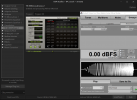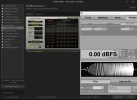ernestcarl
Major Contributor
I asked a rather off-topic question in the ff. post asking why my measured SPL peaks with music playback went above the measured 0dBFS full-range sweep traces generated in REW.

 www.audiosciencereview.com
www.audiosciencereview.com
It turns out I just completely forgot about the fact that music has a dynamic range (duh!) and peaks / crest which is also why one should always ensure adequate headroom is available to prevent any clipping/limiting.
I'm not using an AVR, but a home theater PC with JRiver media center software outputting directly to a multichannel DAC. Maximum reference level is set manually at a much lower level since I only have a single sealed 12" sub that isn't able to reach "THX" reference levels. I do not want to risk bottoming out the sub with LFE signals exceeding well above the subwoofer's compression point... so I've been using a global negative gain on top of JRiver's own built-in or internal digital headroom -- so basically an addtional layer of negative gain per output channel.
Anyway, I assumed that by disabling "volume leveling" and generating a 0 dBFS signal in REW, I would have reached my system's maximum volume limit -- above which the system would automatically "soft clip". However, playing any file or streamed content at max volume -- even with the volume leveling in my software media player turned off -- still gives out LZpeak SPL levels that exceed above the seen visible sweep magnitude trace lines taken at "0 dBFS" in REW.
For one thing, routing audio through the JRiver software automatically automatically applies a ~ 4.7 dB reduction in the digital volume gain (default extra headroom for DSP purposes) as opposed to directly sending the signal to the DAC. Whereas I got a reading of 87.5 dB with a -20 dBFS PN signal sent directly to the left channel of my DAC, I got a reading of 82.5 dB when routing the signal into JRiver's WDM driver (with volume leveling off). Now, with the volume leveling turned on, this will additionally apply a 10 dB negative gain yet on top of the initial -4.7 dB -- giving out a final reading of 72.5 dB at the MLP! So there is indeed already adequate headroom available to account for maximum volume playback.
manual routing with no PEQs running (leveling disabled)

manual routing with all PEQs enabled (leveling still disabled)

Hmmmn... thinking this through again, I would not recommend others, nor dare risk myself sending out a 0 dBFS signal directly to the DAC and speakers -- besides there's always the potential of clipping elsewhere in the chain...
In my case, 87.5 dB (-20 dBFS signal measured at 2.3m) + 20 dB more giving out an theoretical equivalent total of 112-113 dB FULL-RANGE SPL signal at 1 meter! My studio monitor is only spec'd at 102 dB continuous max SPL -- even though the maximum (transient) "peak" is written at 116 dB -- one must assume this is of a limited range (250 Hz - 3 kHz perhaps?)
-------------
BTW, I haven't checked other software media players. But I presume some of them might also apply a negative gain pre-emptively (?) -- the smarter ones with extra DSP features, at least.

Ideas for more meaningful speaker measurements
Give the Highland Brewery a visit. One of 67, but I find their ales to be the best in the state. Thanks! … All that is technical, measurable, tunable. What is not is how your brain inherent, genetic, and training, processes what you hear to decide if it is "musical" or not. Well either...
 www.audiosciencereview.com
www.audiosciencereview.com
It turns out I just completely forgot about the fact that music has a dynamic range (duh!) and peaks / crest which is also why one should always ensure adequate headroom is available to prevent any clipping/limiting.
I'm not using an AVR, but a home theater PC with JRiver media center software outputting directly to a multichannel DAC. Maximum reference level is set manually at a much lower level since I only have a single sealed 12" sub that isn't able to reach "THX" reference levels. I do not want to risk bottoming out the sub with LFE signals exceeding well above the subwoofer's compression point... so I've been using a global negative gain on top of JRiver's own built-in or internal digital headroom -- so basically an addtional layer of negative gain per output channel.
Anyway, I assumed that by disabling "volume leveling" and generating a 0 dBFS signal in REW, I would have reached my system's maximum volume limit -- above which the system would automatically "soft clip". However, playing any file or streamed content at max volume -- even with the volume leveling in my software media player turned off -- still gives out LZpeak SPL levels that exceed above the seen visible sweep magnitude trace lines taken at "0 dBFS" in REW.
For one thing, routing audio through the JRiver software automatically automatically applies a ~ 4.7 dB reduction in the digital volume gain (default extra headroom for DSP purposes) as opposed to directly sending the signal to the DAC. Whereas I got a reading of 87.5 dB with a -20 dBFS PN signal sent directly to the left channel of my DAC, I got a reading of 82.5 dB when routing the signal into JRiver's WDM driver (with volume leveling off). Now, with the volume leveling turned on, this will additionally apply a 10 dB negative gain yet on top of the initial -4.7 dB -- giving out a final reading of 72.5 dB at the MLP! So there is indeed already adequate headroom available to account for maximum volume playback.
manual routing with no PEQs running (leveling disabled)

manual routing with all PEQs enabled (leveling still disabled)

Hmmmn... thinking this through again, I would not recommend others, nor dare risk myself sending out a 0 dBFS signal directly to the DAC and speakers -- besides there's always the potential of clipping elsewhere in the chain...
In my case, 87.5 dB (-20 dBFS signal measured at 2.3m) + 20 dB more giving out an theoretical equivalent total of 112-113 dB FULL-RANGE SPL signal at 1 meter! My studio monitor is only spec'd at 102 dB continuous max SPL -- even though the maximum (transient) "peak" is written at 116 dB -- one must assume this is of a limited range (250 Hz - 3 kHz perhaps?)
-------------
BTW, I haven't checked other software media players. But I presume some of them might also apply a negative gain pre-emptively (?) -- the smarter ones with extra DSP features, at least.
Last edited:
